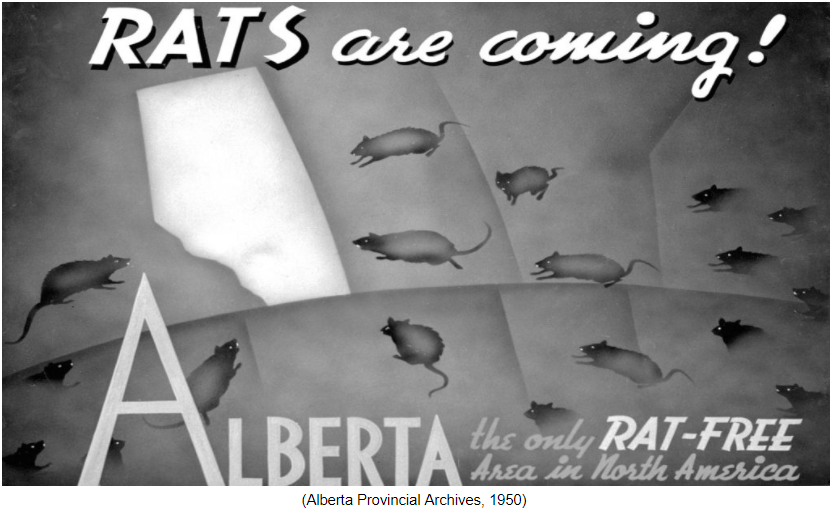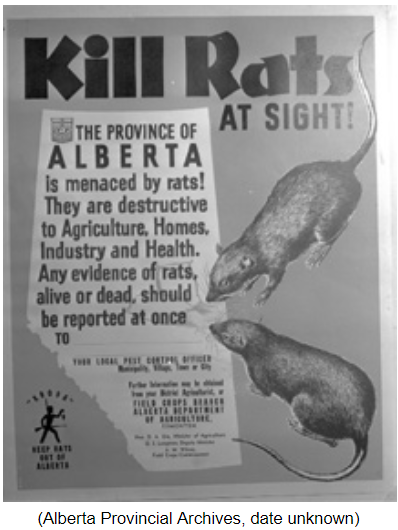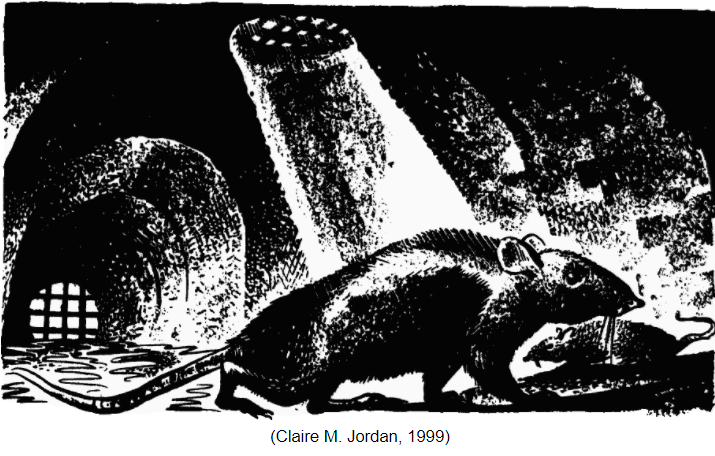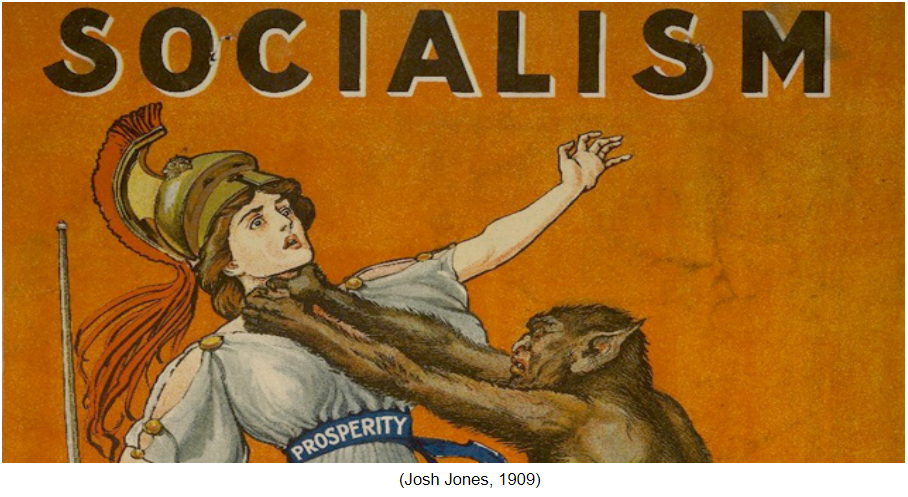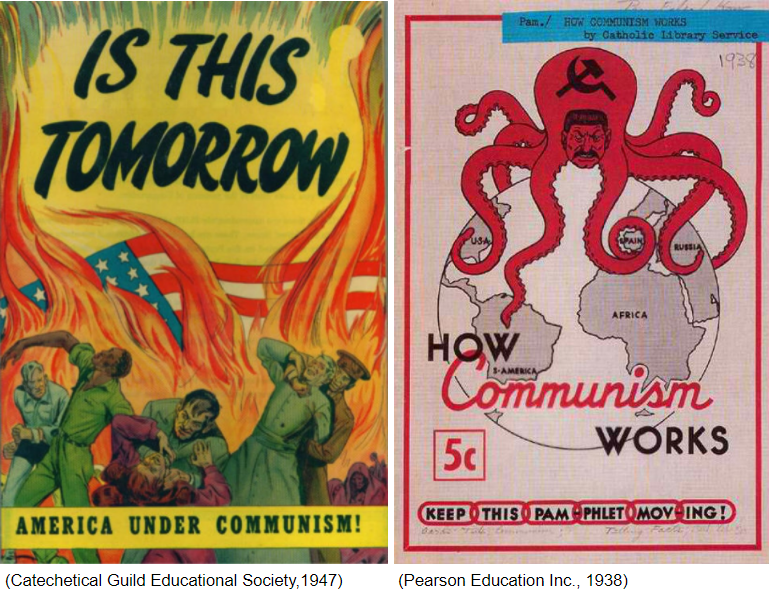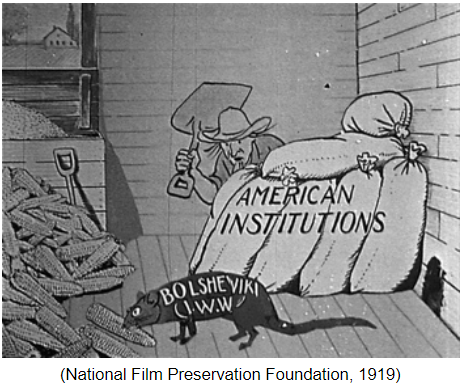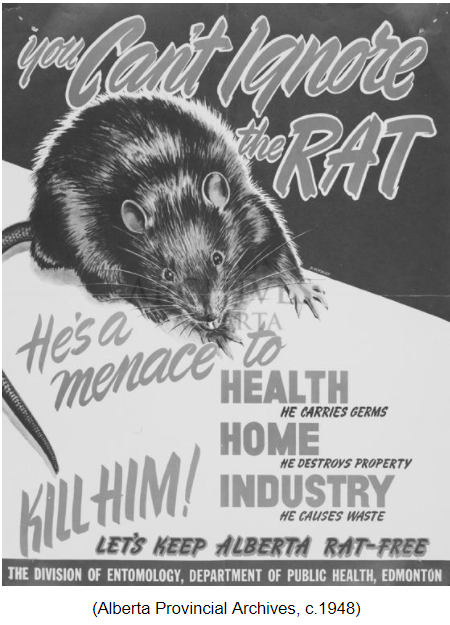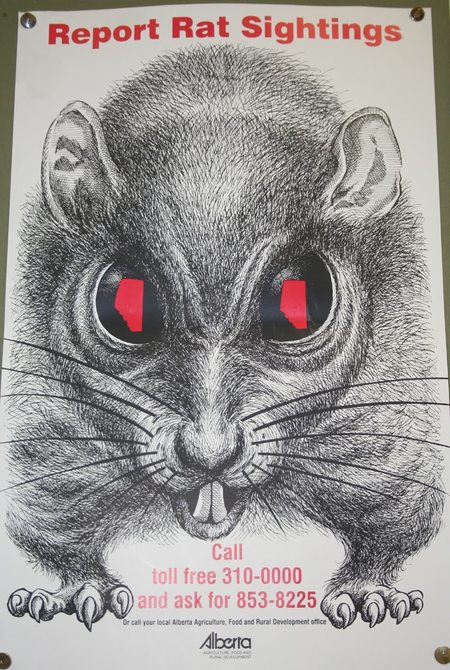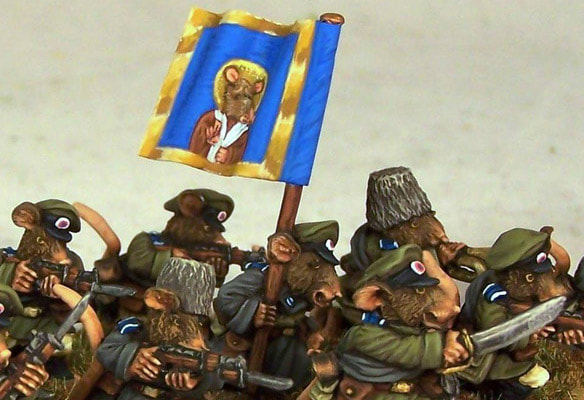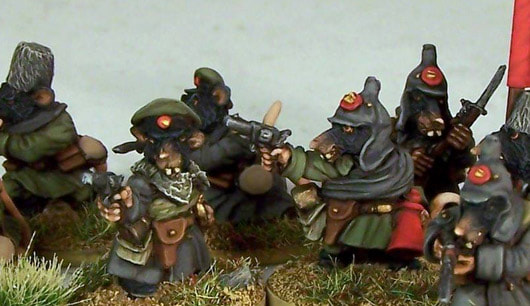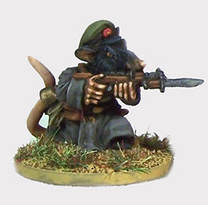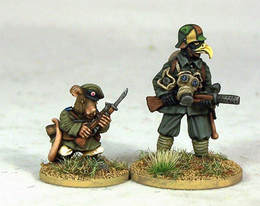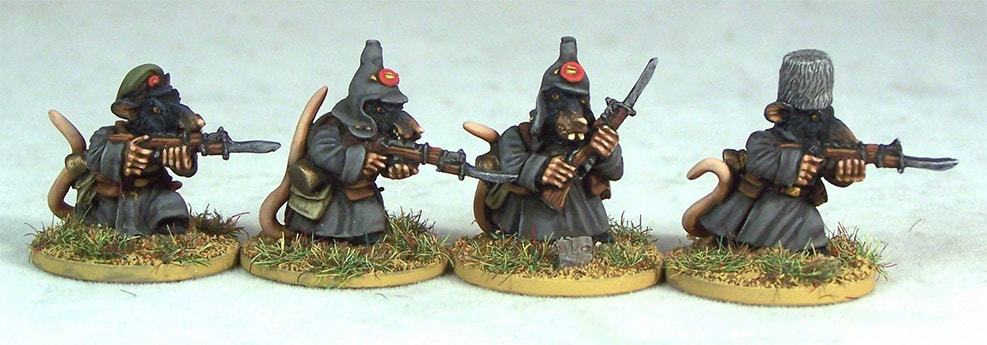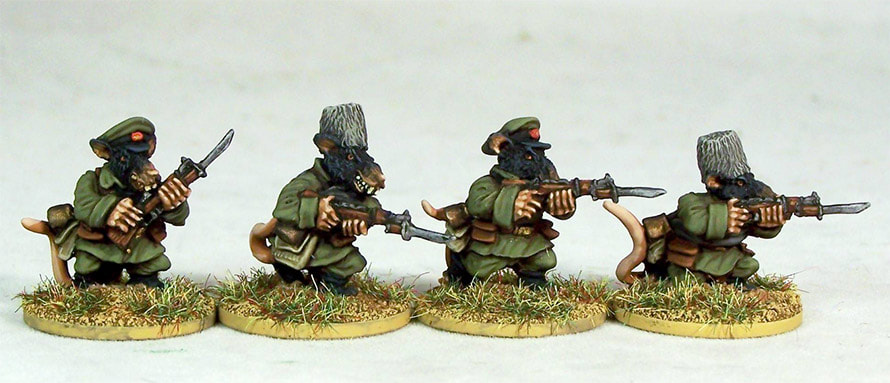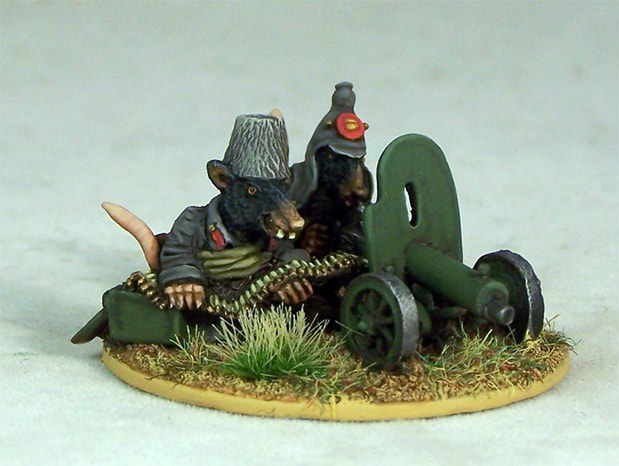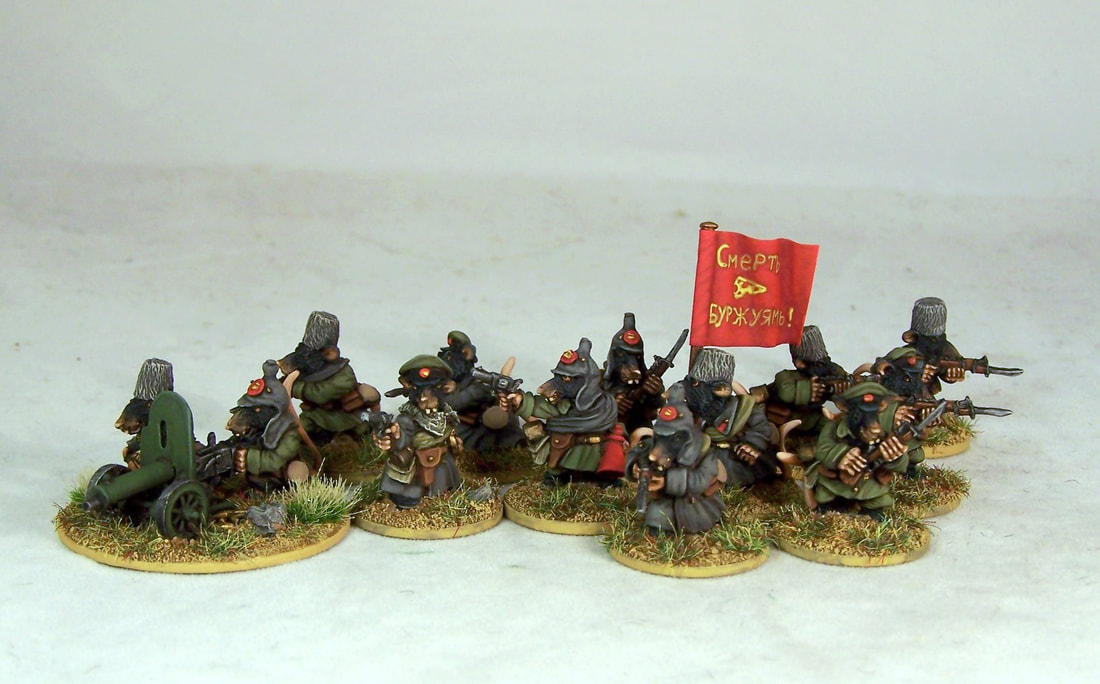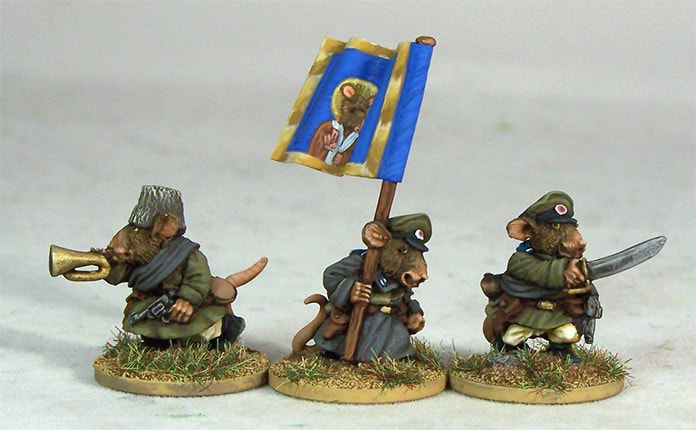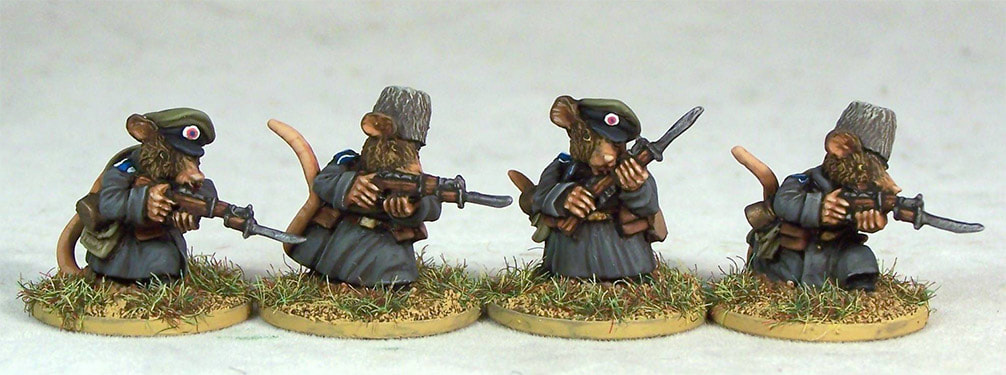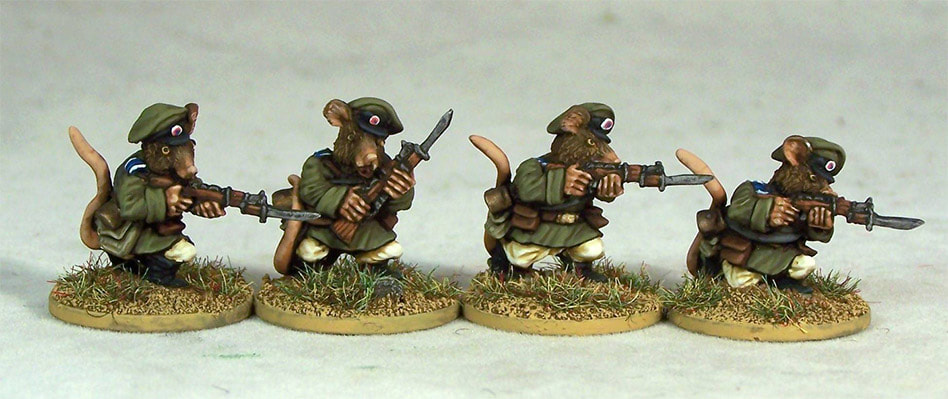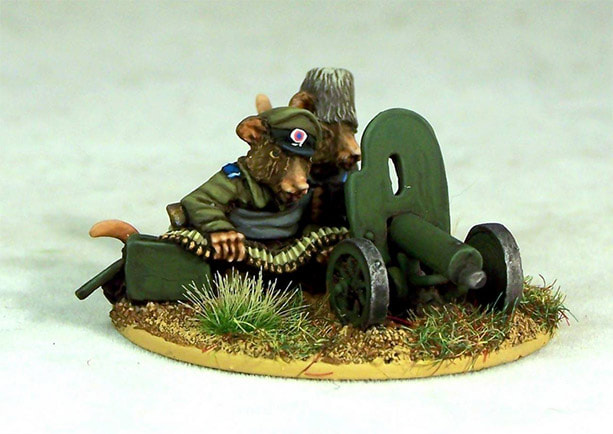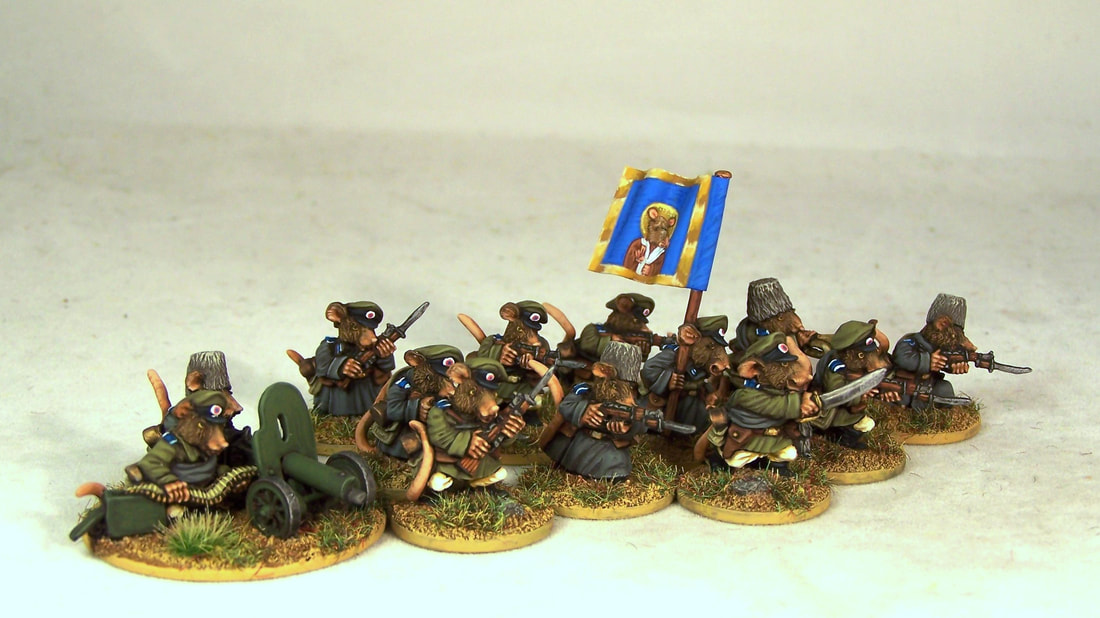Before introducing the next addition to the series, I'm going to share here my term paper for English a few years ago, which I wrote before discovering the following miniatures, but provides an interesting context for them. If it holds no interest, I will not hold it against you for skipping to the end.
In the fall of 2000, the government of Alberta organized a special celebration for a
unique quinquagenarian anniversary. For 50 years the province has boasted the status of being rat-free. This is a more remarkable claim than it might first appear. Rats inhabit every continent in the world except for Antarctica, and have even “reached at least 90% of the world’s islands” (Rachel Nuwer, 2014). Conservative estimates place the worldwide population of rats “at many billion and most consider the highest of all mammals - including humans.” (Jerry Langton, 2006) The United States alone is home to 150 million or more rats (Brian Handwerk, 2003). Alberta is currently the only region in North America free of rats (Frances Reilly, 2016), a point of pride for the province. Brian Bergman writes that “outsiders may be forgiven for believing that what gives Albertans their unique identity is their aversion to a provincial sales tax and a certain fondness for turning right-wing fringe parties into formidable political forces...but no, as important as all that is, what really keeps us united is a common enemy, one that walks on four legs and boasts continuously growing incisors that can chew through anything from electrical wire to concrete.” (Bergman). John B. Bourne, head of Alberta Agriculture's rat control program, states that "we maintain and broadcast our rat-free reputation, so that Albertans know that the province is free of rats." (Handwerk)
unique quinquagenarian anniversary. For 50 years the province has boasted the status of being rat-free. This is a more remarkable claim than it might first appear. Rats inhabit every continent in the world except for Antarctica, and have even “reached at least 90% of the world’s islands” (Rachel Nuwer, 2014). Conservative estimates place the worldwide population of rats “at many billion and most consider the highest of all mammals - including humans.” (Jerry Langton, 2006) The United States alone is home to 150 million or more rats (Brian Handwerk, 2003). Alberta is currently the only region in North America free of rats (Frances Reilly, 2016), a point of pride for the province. Brian Bergman writes that “outsiders may be forgiven for believing that what gives Albertans their unique identity is their aversion to a provincial sales tax and a certain fondness for turning right-wing fringe parties into formidable political forces...but no, as important as all that is, what really keeps us united is a common enemy, one that walks on four legs and boasts continuously growing incisors that can chew through anything from electrical wire to concrete.” (Bergman). John B. Bourne, head of Alberta Agriculture's rat control program, states that "we maintain and broadcast our rat-free reputation, so that Albertans know that the province is free of rats." (Handwerk)
Alberta’s rat-free status “is not by chance but by design,” (John Bourne, 2002) the result of an unprecedented government-sponsored rat control program began in 1950. “While the United States was responding to Cold War pressures by ferreting out Communists, Alberta was busy eradicating a menace in its countryside.” (Dawn Walton, 2000) That the avid hunt to eradicate rats in the province coincides with the communist witch hunts of the “Red Scare” is more than a coincidence, however. Alberta’s war on rats finds its origins and impetus in the communist paranoia that swept North America in the wake of the post World War era. Walton states that “fifty years ago, Reds and rats had something in common: both were targets of government- sanctioned witch hunts.” The comparison is more apt that one might guess. The Albertan war on rats was a reaction to and an expression of the war on Communism, and in effect the two are synonymous manifestations of The Red Scare that gripped Cold War North America.
To comprehend the unusual and extraordinary effort put into Alberta’s anti-rat campaign, it's important to understand how daunting a task is the creation of a rat-free environment. Rats are members of the order Rodentia, the largest order of mammals. “The characteristic that unites this order - and its most conspicuous trait - is a single pair of razor-sharp incisors.” (Ed. Wolff & Sherman, 2007) The name “rodent” itself derives from the Latin rodere, meaning “to gnaw”. The success of rats as a species is largely based on their exceptional adaptability. Jerry Langton notes that it “doesn’t take long for rats to adapt to any environment, no matter how inhospitable it seems...Colonies of rats have even been known to thrive in meat lockers, where constant freezing temperatures would kill humans in a manner of minutes.”(2006) Rats also reproduce at an alarming rate. With a gestation period of roughly 3 weeks and litters between 6 -12, “it's possible for a three-year-old rat to have given birth to forty-three different litters, up to 516 separate births.” (Langton)
Rats possess exceptionally acute senses, a rapidly-evolving immunity to poisons, preternatural agility, and the ability to squeeze through holes no larger than a quarter by collapsing their rib cages at will. (Langton) Though rats will prefer to flee rather than fight, their nails are capable of rending human skin and their bite is an evolutionary wonder. “The hardness of the enamel on the front of the rat’s incisors is comparable to some grades of steel,” notes Langton, “[and they] can exert a force of 7000 PSI in a bite, much greater than the 1000 or so for a dog.” There are actually three types of rat bites; besides the ordinary one for eating, a rat can gnaw through materials including brick, concrete or lead by sliding down a protective membrane, and, when aggressive, their incisors “separate to create a wider wound and more damage.” (Langton) This is to say nothing of the deadliness of a rat’s saliva, host to numerous communicable diseases, with infected bites “fatal in 13% of cases in humans, despite antibiotic treatment.” (Langton)
To comprehend the unusual and extraordinary effort put into Alberta’s anti-rat campaign, it's important to understand how daunting a task is the creation of a rat-free environment. Rats are members of the order Rodentia, the largest order of mammals. “The characteristic that unites this order - and its most conspicuous trait - is a single pair of razor-sharp incisors.” (Ed. Wolff & Sherman, 2007) The name “rodent” itself derives from the Latin rodere, meaning “to gnaw”. The success of rats as a species is largely based on their exceptional adaptability. Jerry Langton notes that it “doesn’t take long for rats to adapt to any environment, no matter how inhospitable it seems...Colonies of rats have even been known to thrive in meat lockers, where constant freezing temperatures would kill humans in a manner of minutes.”(2006) Rats also reproduce at an alarming rate. With a gestation period of roughly 3 weeks and litters between 6 -12, “it's possible for a three-year-old rat to have given birth to forty-three different litters, up to 516 separate births.” (Langton)
Rats possess exceptionally acute senses, a rapidly-evolving immunity to poisons, preternatural agility, and the ability to squeeze through holes no larger than a quarter by collapsing their rib cages at will. (Langton) Though rats will prefer to flee rather than fight, their nails are capable of rending human skin and their bite is an evolutionary wonder. “The hardness of the enamel on the front of the rat’s incisors is comparable to some grades of steel,” notes Langton, “[and they] can exert a force of 7000 PSI in a bite, much greater than the 1000 or so for a dog.” There are actually three types of rat bites; besides the ordinary one for eating, a rat can gnaw through materials including brick, concrete or lead by sliding down a protective membrane, and, when aggressive, their incisors “separate to create a wider wound and more damage.” (Langton) This is to say nothing of the deadliness of a rat’s saliva, host to numerous communicable diseases, with infected bites “fatal in 13% of cases in humans, despite antibiotic treatment.” (Langton)
To humans, rats have long been considered deadly pests. They infiltrated Rome among the many food shipments and are thought responsible for spreading the devastating Antonine Plague that claimed the life of the Emperor Lucius Verus (Paul Erdkamp, 2013) Likewise, rats were long held responsible for spreading the devastating Black Plague that claimed the lives of roughly ⅓ of Europe’s total population from 1346-1353. (David Herlihy, 1997) Every 50 years massive swarms of rats from the bamboo forests sweep across India, devouring crops. (Alasdair Wilkins, 2010) They are considered the world’s worst invasive species, with evidence that rats are to blame for 40 to 60% percent of all seabird and reptile extinctions. (Science Avenger, 2007) According to the United States Fish and Wildlife Service, “each year, rats destroy approximately 20% of all agricultural products in the world.” (2008) But despite this, no place on Earth besides Alberta has made such a concentrated effort at eradicating the vermin. Though measures to ameliorate their harm are taken, for the most part rats are accepted as an unavoidable blight. So what would cause Alberta to expend such vasts amount of money, time, and manpower to warring against nature? To understand that one must look at another threat that captivated North America’s attention in 1950.
The Red Scare is the name typically given to the paranoia and ideological insecurity that swept North America in the years following World War 2. “Domestically, this anxiety and insecurity translated into a widespread concern over internal subversion,…[and] led to spy chasing, police investigations and security screenings, red baiting, accusations of conspiracies, the squashing of legitimate dissent, and smear campaigns.” (David MacKenzie, 2001) By 1949, these fears were exacerbated to a fever pitch by the communist party of China winning the Chinese civil war and the first Soviet tests of atomic weapons. In 1950, the Korean War began, pitting U.S., Canadian and South Korean forces against North Korean and Chinese communists. On the homefront, the war against communists was embodied by Senator Joe McCarthy, to the point that “McCarthyism” is now a common synonym for the Red Scare (Whitaker and Marcuse, 1996). Together with the House Un-American Activities Committee (HUAC), a series of government witch hunts began, along with a propaganda campaign that incited public tensions.
The emergence of a “National Security State” in the U.S. had a profound effect upon its neighbour to the North (Whitaker and Marcuse). “The atomic age changed the way Canadians looked at themselves and forced them to evaluate their place in the world,” writes MacKenzie, “Overnight, Canada went from being a small country ‘far from inflammable materials’...to the territorial buffer between the superpowers...geography made neutrality or isolationism an impossibility,while ideology made Canada a partner...with the United States.” A Canadian variation on HUAC, The Security Panel, was created by Prime Minister MacKenzie King to determine the loyalty of government workers. RCMP screenings were held, with accused individuals denied work or moved to less sensitive positions without explanation or appeal. (Whitaker and Marcuse) Provincial governments “quickly endorsed various levels of witch hunting.” (MacKenzie) The infamous Padlock Law empowered the government to decide what was defined as “communist” and close down any group or publication officials interpreted as propagating communism. (MacKenzie) This was the political climate in which Alberta launched its campaign against rats.
Rats have been associated with communism at least as far back as the Victorian era, when Charles Dickens, in an article for the periodical Household Words, humorously remarked upon a pamphlet he acquired in London entitled Rat!!! Rat!!! Rat!!!, wherein the author comments that “Communism, Socialism, and Ratism - are terms synonymous.” (1851) Richard Nixon, a member of HUAC during the infamous Hollywood trials, gave a speech in which he stated “Reds [are] a bunch of rats. But just remember this: when you go out to shoot rats, you have to shoot straight, because when you shoot wildly it only means that the rats may get away more easily.” (James Cross Giblin, 2009) Pamphlets were handed out during the Hollywood Blacklisting trials that stated “‘Star’ is just ‘rats’ spelled backwards.” (Ellen Schrecker, 1994). The analogy is easy to understand from the point of view of those caught up in the paranoia of the Red Scare. Rats are an omnipresent but seldom visible threat to humanity, gnawing at the infrastructures of civilization. “During this era, communism, much like the rat, was seen as an infiltrating force,” writes Frances Reilly, “ it was an “other” that could invade through the “familiar.” Seemingly “normal” Canadians could in fact be communists, and could spread the ideology through friendship, family, and the home.” (2016)
In 1950, the Alberta government officially declared a “War on Rats.” (Jeremy Berke, 2015) Utilizing a 1942 law, The Agricultural Pest Act, allowing the Ministry of Agriculture to “designate any animal likely to destroy crops or livestock a pest,” (Reilly, 2016), rats were deemed an official threat to be killed on sight. Rat Patrols were created, but the ultimate success of the venture depended on civilian participation. To that end a propaganda campaign was initiated that mirrored the anti-communist campaigns in the States. Whereas U.S. citizens were watching the public service films such as The Red Scare, “Albertans were fed a steady diet of anti rat animus.” (Walton). Posters extolling the “Rat Menace” even made obvious allusions to the parallels between “the rat’s historical migration from east to west and the feared spread of communism along the same trajectory”. (Reilly) As U.S. citizens were entreated to monitor each other for subversive behaviour, Albertans were encouraged to keep watch for signs of rodent incursion. (Reilly) “While it might be tempting to scoff at the comparison between rodent and ideological control...both governments used similar tools of persuasion to urge residents to, well, rat out enemies of the state.” (Walton) And just as suspected Communists in Hollywood ended up testifying in HUAC trials, “Albertans who didn't control rats ended up in court.” (Reilly)
In 1950, the Alberta government officially declared a “War on Rats.” (Jeremy Berke, 2015) Utilizing a 1942 law, The Agricultural Pest Act, allowing the Ministry of Agriculture to “designate any animal likely to destroy crops or livestock a pest,” (Reilly, 2016), rats were deemed an official threat to be killed on sight. Rat Patrols were created, but the ultimate success of the venture depended on civilian participation. To that end a propaganda campaign was initiated that mirrored the anti-communist campaigns in the States. Whereas U.S. citizens were watching the public service films such as The Red Scare, “Albertans were fed a steady diet of anti rat animus.” (Walton). Posters extolling the “Rat Menace” even made obvious allusions to the parallels between “the rat’s historical migration from east to west and the feared spread of communism along the same trajectory”. (Reilly) As U.S. citizens were entreated to monitor each other for subversive behaviour, Albertans were encouraged to keep watch for signs of rodent incursion. (Reilly) “While it might be tempting to scoff at the comparison between rodent and ideological control...both governments used similar tools of persuasion to urge residents to, well, rat out enemies of the state.” (Walton) And just as suspected Communists in Hollywood ended up testifying in HUAC trials, “Albertans who didn't control rats ended up in court.” (Reilly)
The parallels between Alberta’s War on Rats and the Red Scare are numerous and obvious, which ultimately leaves only the question of why a nationwide fear of communism would manifest in such a unique and specific manner in Alberta? Communist paranoia was a fueled by anxiety and uncertainty. What the war on rats provided was a tangible enemy, a scapegoat that focused the aggression and fear regarding communist infiltration upon a physically identifiable threat. The rodent became an antagonist for Albertans to rally against and a battle that ultimately could be won in a way the Cold War never could. In this manner, Alberta is perhaps additionally unique in North America for dealing with the Red Scare in the healthiest way possible. As Reilly puts it, “viewing the rat control program through the perspective of Cold War disaster management, the campaign successfully endeavoured to control chaos at a time of measured disorder, anxiety, and potential disaster, with corresponding environmental effects that have lasted up to the present day.”
Now 60 years from its Cold War origins, Alberta’s War on Rats continues on well after McCarthy was discredited. The Rat Patrol regularly hosts educational programs in Alberta’s elementary schools, and citizens still keep a watchful eye for any signs of rodent infiltration. For a modern Albertan, the province’s remarkable status as a rat-free environment is an essential part of their identity and something that defines them as unique in the world. While Alberta may have started out symbolically hunting communists, Albertans ended up cementing a sense of community and provincial pride.
Now 60 years from its Cold War origins, Alberta’s War on Rats continues on well after McCarthy was discredited. The Rat Patrol regularly hosts educational programs in Alberta’s elementary schools, and citizens still keep a watchful eye for any signs of rodent infiltration. For a modern Albertan, the province’s remarkable status as a rat-free environment is an essential part of their identity and something that defines them as unique in the world. While Alberta may have started out symbolically hunting communists, Albertans ended up cementing a sense of community and provincial pride.
Okay, so what does all that have to do with Ratmen miniatures? Well, lo and behold gentlerats and maladies - Khurasan Miniatures' Rodent Civil War line:
"When war against Adlers was lost, Caesar Mouse was overthrown, and rats rose up, saying all cheese belongs to everyone. Menshimice did not concur and pressed war against Bolshirats. Bolshirats were led by Kommissars who gave many "incentives" to rats to fight against Menshimice. "
Sculpted by Bob "Lord of the Dwarves" Olley, the Bolshirats are 28mm scale (though stand 20mm in height in comparison to the taller Adlerkorps) and are astoundingly detailed.
The examples shown here were painted by one Andrew Taylor, and based on these I'd love to see him try his hand at some Goodwin Skaven.
Bolshirat Infantry Command
Bolshirats with Mousin-Nagant Rifles in Overcoats
Bolshirats with Mousin-Nagant Rifles in Jackets
Bolshirat Heavy Machine-Gun Team
Bolshirat Platoon
Menshimice Infantry Command
Menshimice with Mousin-Nagant Rifles in Overcoats
Menshimice with Mousin-Nagant Rifles in Jackets
Menshimice Heavy Machine-Gun Team
Menshimice Platoon
COMING UP: Kickstarter Rats!
